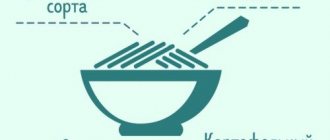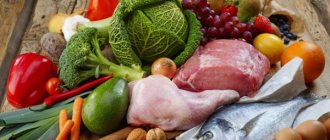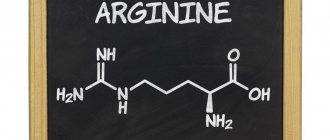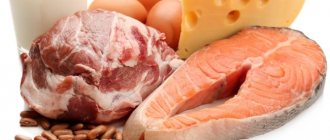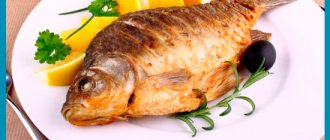High-fat varieties from seas and rivers
It has been proven that any sea or river fish is much healthier for the body than animal meat. Fillet dishes turn out very tender, soft and pleasant. When cooked, river and sea pulp loses a minimal amount of liquid due to the large amount of easily digestible protein and the small amount of connective tissue.
The list of microelements and the level of fat content depends on the habitat of the fish, the age, sex of the fish and the time of year in which it is caught. River varieties contain lower amounts of vitamins A, B and D, iodine and magnesium, but river pulp contains more easily digestible iron.
Sometimes the fillet has a specific smell of mud with algae. The value of dietary fiber from fish from the sea is greater than that from river fish, since the pulp contains a large amount of proteins, vitamins soluble in water, iodine and polyunsaturated acids.
All fish varieties can be divided into the following categories according to the degree of fat content:
- low-fat (up to 3%) – pike perch, crucian carp, pike meat, pollock, mullet, pike, small roach, omul;
- medium fatty (up to 9%) – herring, perch, carp, pink salmon, carp, horse mackerel, tuna;
- high-fat (up to 30% or more) - saury, salmon fillet, lamprey, eel, mackerel, herring, catfish, sturgeon, asp.
Omega 3 acids in salmon
With a slight difference of 0.4 grams, another fatty sea fish ranks second in terms of the content of polyunsaturated fatty acids - salmon; 100 grams of salmon meat contains 3.9 grams of omega-3, which completely covers the daily requirement of an adult. By the way, this fish is on the list of foods that increase testosterone levels.
A pleasant and useful bonus to PUFAs is a number of minerals and vitamins, such as: potassium and sodium, magnesium, calcium and iron; vitamin B-12 and B-6, ascorbic acid, C and A.
Beneficial properties of fatty fish
The fat in a fish carcass is concentrated in the intestinal and abdominal areas. Meat can contain up to 30% fat depending on the type of fish, and its volume also increases during the spawning period of fish. The fatty pulp is rich in omega 3 and 6 fatty acids, vitamins, macro- and microelements, which ensures the full functioning of all vital systems of the human body.
Fish pulp is almost completely digestible, which has a complex beneficial effect on the body. Regular consumption of fatty fish reduces the risk of cardiovascular diseases. Phosphorus in the composition improves the condition of tooth enamel, strengthens hair, brightens the skin and strengthens the musculoskeletal system.
Fatty acids work together to reduce cholesterol, enhance tissue regeneration, increase protective function, and improve the condition of bones. The effects of acids activate brain activity, improve immunity and visual acuity.
For baby food, fatty fish is extremely necessary, since vitamins have a beneficial effect on the mental development of children, sharpen attention, improve memory and perception of the surrounding reality.
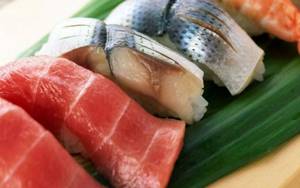
Valuable elements of fish meat have a calming, activity-suppressing effect, produce happiness hormones and improve mood.
Omega 3 acids in mackerel
Mackerel is rightfully considered the leader among food products of animal origin in terms of omega-3 content - 100 grams of this fatty fish contains 4.3-5 grams of polyunsaturated fatty acids. The beauty of this product is that it is very tasty and retains its advantages, even if you decide to marinate or pickle the mackerel.

A small portion of this fish will not only completely cover the daily intake of omega-3, but will also become an additional source of the vitamins we need - B-12 and B-6, A and ascorbic acid, as well as minerals - magnesium, calcium and iron.
Possible harm
Fatty fish can have negative effects on the body. Before eating, raw materials should be carefully inspected for damage, and the catch region should be clarified to eliminate the possibility of poisoning.
People with allergies should not eat it; during pregnancy, saury, pink salmon, tuna and hake should be excluded from the menu. It is better not to consume raw fish pulp due to the possible presence of bacteria in the meat.
Important! You should not store fatty fish fillets in a warm place or in sunlight for a long time, since in the light, fat oxidation processes that are harmful to the body grow in the flesh.
Proper preparation of fish for diet

For people who decide to go on a diet, the best option is to eat fish dishes. Such dishes help to endure such a difficult period for the body much easier. Due to the fact that the dishes are low-calorie, excess weight loss is stimulated; in addition, they perfectly satisfy the appetite.
The most important thing is to prepare dishes in such a way that they retain as many useful components as possible. Therefore, experts advise eating boiled, stewed or baked foods.
Dietary food does not include fried, smoked, salted or dried seafood. You should also not get carried away with canned fish.
Seafood can be used to prepare very varied and quite tasty dishes with a low calorie level. Therefore, you can prepare soups, cutlets, meatballs from fish, but only steamed, as well as casseroles and soufflés.
Interesting to know! Low-fat varieties of fish will not only help solve the problem of excess weight, but will also help cope with some diseases of the gastrointestinal tract. Due to the low calorie content, food is easily digested and digested without burdening the stomach.
Daily consumption of fish dishes allows you to regularly replenish the human body with all the necessary beneficial components, beneficially affecting the functioning of all internal organs. This allows you to lose weight, strengthen the immune system, optimize the functioning of the central nervous system, prevent aging of the body by rejuvenating the skin, etc.
Which red fish is the fattest?
The leading positions in terms of fat content are occupied by all varieties of salmon fish. Depending on the time of year, the volume of fat in the pulp ranges from 10 to 20%. More pleasant, tender and non-bony meat is characteristic of trout, salmon and salmon.
Salmon is a red fish that has a high concentration of omega 3 and 6 fatty acids, so eating salmon will protect the body from gastrointestinal diseases, thrombophlebitis, and liver diseases. It is better to fry salmon on a grill pan using oatmeal, flour and starch breading.
It is also convenient to smoke fish, marinate, salt and add to salads, appetizers and put on sandwiches. The optimal cooking method is considered to be baking fish in foil or a cooking bag, as well as eating the tender flesh lightly salted.
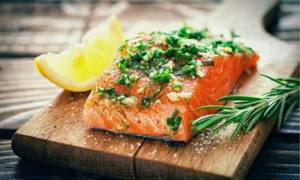
Do not weigh down the meat with a lot of oil and seasonings.
How to choose the right fish
Preference should be given to sea fish, preferably caught in Russia - salmon, cod, haddock, pollock, Atlantic herring (the most budget-friendly) - they contain the maximum amount of useful substances and are initially treated with a natural disinfectant - salt water. The storage period for chilled fish is 3 days. But, the following rules when purchasing must be followed in order to choose a quality product:
- Fresh, when pressed on the carcass, it quickly returns to its original position and leaves no dents.
- The characteristic smell of the sea and mud when the gills are raised.
- By color grade: The bright red color of the gills indicates freshness.
- The scales should be thick and moist, not dry.
- A product that bends well is fresh, but one that has been lying around can break when bent.
- The smaller the fish, the lower the concentration of harmful substances in it.
The fattest fish in the world
Euchalon is named the fattest fish in the world. About 200-300 years ago, the inhabitants of Canada used it in dried form as a wick for lighting rooms. Euchalon lives in the Pacific Ocean, its fillet has a fat content of more than 40%, which means that the pulp is not suitable for dietary nutrition.
In Eastern Europe, the fattest fish, golomyanka, lives on the cleanest Lake Baikal. Its carcass is almost completely transparent, and the length of the carcass can reach from 15 to 25 cm. When you try to cook golomyanka, you will end up with a pan full of fat and a skeleton without meat. It is this northern fish that is the basis of the menu of all other inhabitants of the north of Baikal.
Important! In domestic waters there is a pearl fish called bleak, which makes excellent canned food for the winter.
Omega 3 acids in oysters
Oysters, despite their high price and original, refined taste, are inferior in the amount of polyunsaturated fatty acids to all the above-listed and more affordable fish. 100 grams of oysters contain up to 3 grams of omega-3, but they have their own invaluable benefits.
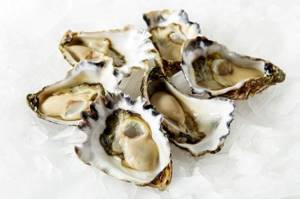
These sea mollusks simply break records in their nutritional value and the content of such a useful trace element as zinc - a hundred-gram serving of oysters contains more than 500% of the daily intake of Zn. Among other things, they contain large amounts of potassium, iron, calcium and sodium. Plus a number of vitamins - C (ascorbic acid), vitamins A, B6 and B12.
Description of varieties
The proposed description of river and sea fish will allow you to understand the advantages and disadvantages of fatty fish fillets.
Low-fat fish for diet
- Eel (up to 30%) is a delicious ocean fish with an increased amount of proteins, sodium, magnesium, potassium, copper, manganese, selenium, vitamins B, A, D. Eel meat has a positive effect on the cardiovascular and nervous system, has a rejuvenating effect , treats eye diseases.
- Mackerel (depending on the season 13-27%) - the fish is considered one of the fattest inhabitants of the sea. The fillet contains iodine, phosphorus, zinc, chromium, sodium, amino acids, vitamins of groups A, E, B, PP. Consumption of mackerel has a preventive effect against cancer. Mackerel is shown as part of the menu for nursing mothers, the elderly and children. Large mackerel increases the body's resistance to harmful influences, strengthens the heart and blood vessels.
- Herring (19.5%) is a marine and oceanic inhabitant, popular due to its high content of potassium, proteins and antioxidants. There are no carbohydrates in herring. The pulp has a preventive effect on the health of the heart, blood vessels, vision and blood.
- Salmon (13.6%) is a sea creature that combines a complex of vitamins B, A, D, omega 3 acids, proteins and minerals. Salmon steaks are considered healthy foods. Salmon has regenerative properties and has an anti-inflammatory effect. The pulp will strengthen blood vessels, improve heart function, and sharpen brain function.
- Capelin (7.2%) is an oceanic fish with a high content of amino acids, protein, potassium, fluorine, and sodium. Consumption will improve the functioning of the thyroid gland, brain and heart. The pulp, even with a high calorie content, is indicated for diabetics.
- Carp (5.3%) – inhabitant of fresh rivers and lakes. The fish has a sweetish taste of the flesh with a delicate and elastic fiber texture. Meat contains large amounts of magnesium and potassium, which improves the functions of the musculoskeletal system, restores the nervous system, improves the quality of hair and nails, and strengthens bone tissue. In terms of cost, carp are more budget-friendly than sea creatures.
- Trout (5%) – can live in rivers and seas. The color of the fillet can vary from pale red to white. Trout is famous for its high taste. The composition contains riboflavin, magnesium, potassium, folic and nicotinic acid. Systematic consumption of trout improves brain performance and accelerates metabolic processes in the body.
- Halibut (4%) is a type of flounder fish. Halibut is distinguished by its tender fillet with a pleasant characteristic sourness. Fillet contains folic acid, phosphorus, copper, selenium, and vitamins. The complex of useful substances accelerates metabolic processes and has a regenerating effect.
- Tilapia (3.7%) is an inhabitant of fresh waters with an excellent taste of meat. Tilapia is allowed for children's menus and for consumption by pregnant women. The pulp has a balanced composition of vitamins and minerals, but there is a high probability of purchasing a contaminated product.

It is necessary to ensure that the carcass of any variety is fresh, free of foreign odors and stickiness
Classification of fish by fat content
In addition to these beneficial substances, fish contains vitamins A, E, F, D, lipids and minerals. In terms of composition, the main substances are contained in the following ratio:
- Water – from 46% to 92%;
- Fats from 1 to 8%;
- Minerals up to 4%;
The protein content is relatively constant, ranging from 10-20%.
The value of eating a product refers to the balance of nutrients necessary for well-being, mood and mental activity, this is confirmed by scientific research around the world. Sold chilled and frozen, in the form of semi-finished products.
The general classification is divided into three main groups:
- lean varieties;
- medium grades;
- saturated varieties.
Low-fat ones include:
- River: pike, bream, pike perch, perch (cost from 100 to 200 rubles per kilogram) - cheap species.
- Sea: flounder, cod, hake, blue whiting, pollock, haddock (cost from 150 to 300 rubles per kilogram).
The most dietary fish on this list is cod. All representatives of the low-fat group are easily digestible and are recommended for inclusion in weight loss diets. The indicator of this group is up to 4%, energy value per 100 g. from 70 to 100 kcal.

The list of medium fatty breeds includes:
- Trout, carp, catfish, crucian carp are river inhabitants (price from 200 to 400 rubles/kg).
- Tuna, pink salmon, herring, chum salmon, perch – sea (from 250 to 350 rubles/kg).
These samples are ideal for balanced nutrition for athletes during periods of heavy loads and people leading an active lifestyle. The beneficial properties are well preserved when steamed or baked. Calorie content from 90 to 140 kcal, an indicator from 4 to 8 percent.
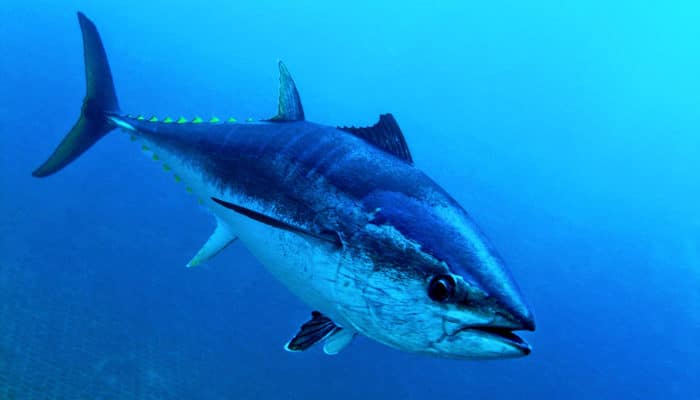
The following contain from 8% fat, energy value ranging from 200 to 250 kcal per 100 g. product. The names of these species: halibut, saury, mackerel, stellate sturgeon, beluga, sturgeon and sturgeons, herring, sabrefish, burbot, Atlantic herring - sea inhabitants (the cost is high, from 200 to 1500 rubles / kg).
In terms of nutrients, these types are the most caloric and healthy, containing a lot of iodine and omega-3 fatty acids. They protect blood vessels and regulate blood pressure. The weekly norm of omega-3 is contained in 300 grams of fatty fish.
For those who care about their health, fatty fish must be present in their diet. It is optimal to consume fish products of different fat content. All varieties are represented on the Russian market.
List of varieties with fat content
The presented table provides a detailed list of high-fat sea and river fish varieties with a description and nutritional value.
| Name | Fats (g/100g) and calories (kcal/100g) | Features of the view |
| Catfish | 5.3/126 | The pulp can be consumed in any form: baked, boiled and fried. Fillet has a beneficial effect on thinking processes. |
| Cod | 0.7/78 | The high nutritional value of meat and liver improves the structure of the blood and improves the functioning of the heart muscle. |
| Trout | 2.1/97 | Carcasses rich in omega-3 acids are best obtained baked. Which trout tastes better is a matter of personal taste. |
| Mackerel | 13/181 | Does not cause allergies, it is best obtained lightly salted. |
| Pink salmon | 6.5/142 | It is better to use fillet for cooking in the oven. Meaty fillet perfectly absorbs spices and sauces. |
| Salmon | 13/201 | A valuable variety of fish that goes well with cream, cheese, and vegetables. Quickly saturates the body and is completely absorbed. |
| Flounder | 1.8/78 | Has a beneficial effect on the thyroid gland and immunity. |
| Pangasius | 3/90 | Dishes with pangasius improve metabolic processes, stabilize the nervous system and improve skin condition. |
| capelin | 11.5/157 | The composition contains a high content of B vitamins, which stabilize the amount of cholesterol in the blood. Dried, smoked and fried capelin tastes best. |
| Seabass | 15.3/99 | White fish with elastic, boneless meat goes well with vegetables, white sauces and rice. |
| Salmon | 6/140 | Improves blood flow, protects against blood clots. Fillet requires a minimum of spices and is combined with breading, vegetables, honey and soy sauce. |
| Tuna | 1/101 | “Sea beef” reduces the risks of cancer and inflammation. A vegetable side dish or frenchoza goes well with the fish. |
| Chum salmon | 5.6/139 | Prevents atherosclerosis, speeds up metabolism, and is a delicious treat on the holiday menu. |
| Halibut | 3/102 | Sharpens vision, saturates the body with vitamins. |
Fish calorie table
The table indicates the amount of fats, proteins, carbohydrates per 100 g of product. From them you can determine the calorie content and varieties suitable for preparing dietary fish.
| Fish name | Calories, kcal | Proteins, g | Fats, g | Carbohydrates, g |
| Low fat | ||||
| Boiled flounder | 103,00 | 18,3 | 3,3 | — |
| crucian carp | 102,00 | 20,7 | 2,1 | — |
| Mackerel | 124,00 | 22,8 | 3,6 | — |
| Pollock | 79,00 | 17,6 | 1,00 | — |
| Burbot | 92,00 | 21,4 | 0,7 | — |
| Sea bass | 112,00 | 19,9 | 3,6 | — |
| Blue whiting | 81,00 | 17,9 | 1,00 | — |
| Zander | 97,00 | 21,3 | 1,3 | — |
| Cod | 69,00 | 18,5 | 0,7 | — |
| Hake | 95,00 | 18,5 | 2,3 | — |
| Pike | 97,00 | 21,3 | 1,3 | — |
| Shrimps | 95,00 | 18,9 | 2,2 | — |
| Krill | 98,00 | 20,6 | 1,7 | — |
| Crabs | 96,00 | 16,00 | 3,6 | — |
| Mussels | 50,00 | 9,1 | 1,5 | — |
| Tuna | 96,00 | 22,5 | 0,7 | — |
| Horse mackerel is cold. smoking | 94,00 | 17,1 | 2,8 | — |
| Medium fat | ||||
| Boiled pink salmon | 168,00 | 22,9 | 7,8 | — |
| Pink salmon | 136,00 | 20,9 | 5,6 | — |
| Catfish | 114,00 | 15,5 | 5,8 | — |
| Carp, carp | 125,00 | 19,4 | 5,3 | — |
| Bream | 126,00 | 20,9 | 4,7 | — |
| Salaka | 159,00 | 22,00 | 7,2 | — |
| Horse mackerel | 133,00 | 20,8 | 5,6 | — |
| Squid | 110,00 | 18,00 | 4,2 | — |
| Chum salmon | 129,00 | 21,5 | 4,8 | — |
| Cold smoked mackerel | 150,00 | 23,4 | 6,4 | — |
| Dried roach | 235,00 | 46,4 | 5,5 | — |
| High fat | ||||
| Sardine | 178,00 | 20,1 | 10,8 | — |
| Mackerel | 211,00 | 19,6 | 14,7 | — |
| Som | 196,00 | 18,4 | 13.6 | — |
| Halibut | 201,00 | 14,00 | 17,8 | — |
| Beluga blanched | 234,00 | 23,3 | 15,6 | — |
| Carp in tomato sauce | 145,00 | 12,4 | 8,7 | 4,1 |
| Red sockeye salmon | 170,00 | 18,8 | 10,5 | — |
| Sturgeon | 183,00 | 16,4 | 10,6 | — |
| Spicy salted sprat | 154,00 | 14,8 | 10,5 | — |
| Flounder fried in oil | 249,00 | 14,4 | 21,3 | — |
| Saira blanched in oil | 283,00 | 18,3 | 23,3 | — |
| Salted pink salmon | 189,00 | 22,1 | 9,00 | — |
| Salted chum salmon | 184,00 | 24,3 | 9,6 | — |
| Salted salmon | 269,00 | 21,00 | 20,5 | — |
| Iwasi salted herring | 173,00 | 17,5 | 11,4 | — |
| Hamsa salted | 166,00 | 21,2 | 9,00 | — |
| Salted sprat | 225,00 | 19,8 | 18,2 | — |
| Hot smoked flounder | 192,00 | 22,00 | 11,6 | — |
| Hot smoked sprat | 162,00 | 21,3 | 8,5 | — |
| Sea bass is hot. smoking | 175,00 | 23,5 | 9,00 | — |


